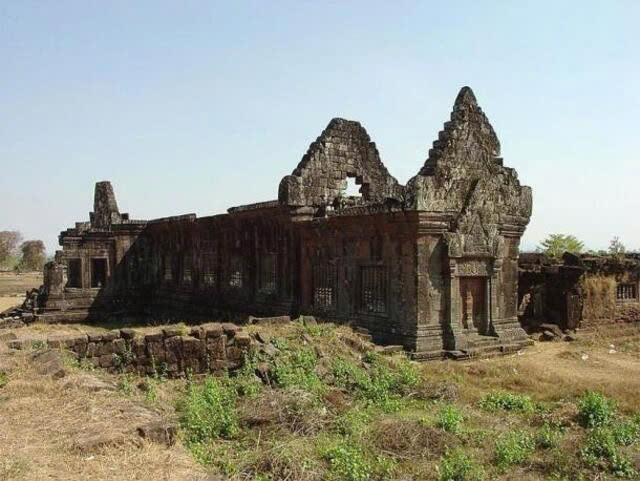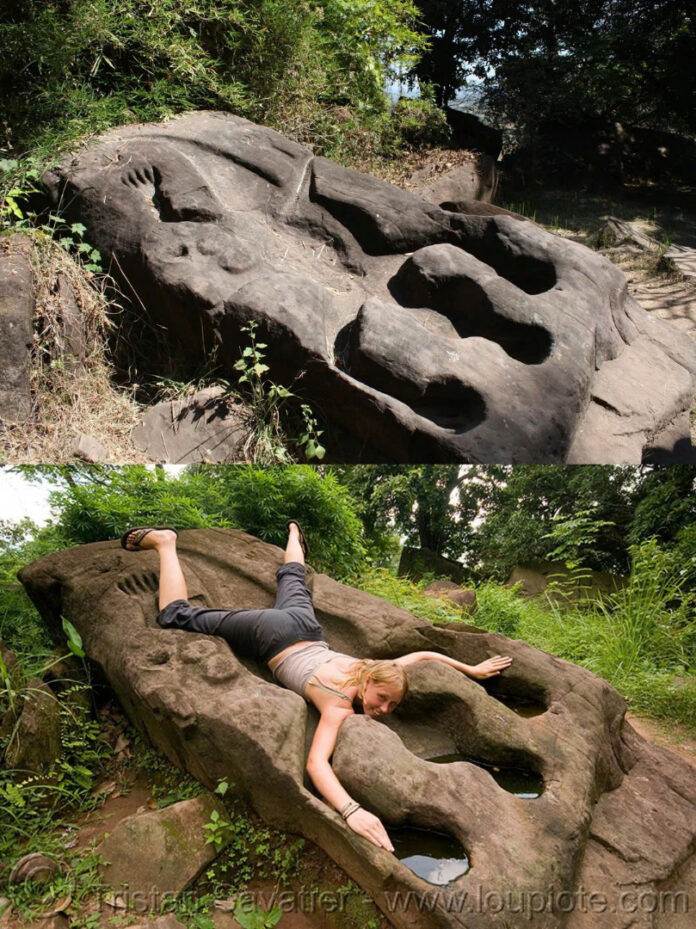Hidden within the ancient temple ruins of Vat Phou in Laos lies one of archaeology’s most perplexing mysteries—a colossal stone carved with the perfect silhouette of a crocodile, featuring a haunting human-shaped cavity that continues to baffle scholars and ignite the imagination of all who encounter it.
The Temple Complex: A Sacred Journey Through Time
Vat Phou’s Spiritual Origins

Positioned majestically against the holy slopes of Phu Kao Mountain in Champasak Province, the Vat Phou Temple complex represents one of Southeast Asia’s most extraordinary archaeological wonders. This UNESCO World Heritage Site dates back to the 5th century, when ancient architects selected this location for its profound spiritual importance—the mountain was venerated as Lingaparvata, Shiva’s sacred abode and the earthly representation of the cosmic Mount Meru.
The Khmer Empire’s Architectural Legacy
During the 11th to 13th centuries, under Khmer rule, the temple complex achieved its architectural pinnacle. Masterful engineers designed an elaborate pilgrimage pathway beginning at the powerful Mekong River and ascending through meticulously planned terraces toward the mountain peak. This holy route winds past twin water reservoirs known as barays, symbolizing the celestial waters of Hindu mythology, before reaching the impressive North and South Palace structures that stand guard over the lower ceremonial areas.

The pilgrimage culminates at the primary sanctuary, dramatically positioned 75 meters above the river valley. Here, ingenious builders channeled a natural spring to flow continuously through the temple, eternally purifying the sacred linga stone—a remarkable demonstration of both engineering prowess and spiritual devotion.
The Crocodile Stone: An Archaeological Enigma
A Singular Discovery

Among all of Vat Phou’s fascinating artifacts, the Crocodile Stone stands alone in its ability to mystify and intrigue. This massive boulder, strategically located near the upper temple levels, displays a profound natural depression that bears an uncanny resemblance to a resting crocodile. The stone’s most striking feature is the meticulously carved human-sized hollow within its surface—a characteristic that has generated numerous theories regarding its ancient function.
Ancient Tales of Sacred Ceremonies
Local folklore, preserved through generations of storytelling, recounts mysterious rituals performed during the Chenla Kingdom period. These narratives describe yearly ceremonies where monarchs would petition mountain deities for divine blessing, presenting offerings of precious rice wine alongside more solemn gifts—beautiful young women chosen for sacrifice when the frangipani flowers marked the changing seasons.
These legendary accounts find surprising support in historical documentation. The ancient Sui Chronicles, recorded by Chinese historians in the 6th century, describe comparable ceremonial practices within Chenla society, detailing rites devoted to Bhadreshvara—a formidable aspect of Shiva. Intriguingly, these historical records locate such ceremonies atop Phu Kao Mountain’s peak, rather than at the enigmatic stone formation below.
Scientific Investigation and Scholarly Theories
The Evidence Gap

Despite the captivating legends surrounding the Crocodile Stone, modern archaeologists encounter a significant absence of tangible proof. No comparable artifact has been found throughout Laos or Cambodia, making this stone a singular anomaly in the regional archaeological landscape. The notable lack of crocodile imagery in Chenla and Khmer religious iconography adds another layer of complexity to understanding its significance.
Contemporary scholars have developed alternative hypotheses—the stone may have functioned as a ceremonial platform for gentler rituals, or its unique form might have carried symbolic meaning that has been lost through the ages. Without comprehensive excavation and detailed analysis, the stone’s authentic purpose remains tantalizingly elusive.
Untapped Archaeological Potential

The mystery becomes even more intriguing when considering that only approximately 5% of the entire Vat Phou complex has undergone systematic archaeological investigation. Extensive portions of the site lie concealed beneath centuries of accumulated soil, potentially harboring vital evidence about the Crocodile Stone’s role in ancient religious practices.
Contemporary challenges further complicate research efforts. Infrastructure projects, including major highway construction, have already impacted sections of the archaeological site. The absence of comprehensive conservation initiatives means that numerous secrets of Vat Phou, including the truth behind its mysterious Crocodile Stone, may remain forever buried.
Video
Cultural Evolution: From Hindu Sanctuary to Buddhist Monastery
Religious Transformation

After the Khmer Empire’s decline, Vat Phou experienced a remarkable metamorphosis during the 13th century, transitioning from a Hindu ceremonial complex into a Theravada Buddhist monastery. This change represented not an end to its spiritual importance, but rather the beginning of a new era in its sacred history.
The founding of the Lan Xang Kingdom in the 14th century further established Vat Phou’s significance as a major regional pilgrimage site. Today, this tradition continues through the annual Vat Phou Festival each February, attracting thousands of pilgrims and visitors who come to experience its lasting spiritual energy.
The Persistent Mystery: A Bridge Between Past and Present
The Crocodile Stone endures as Vat Phou’s most compelling puzzle—a silent guardian that connects historical reality with mythical storytelling. Whether it once functioned as a sacrificial altar, a ceremonial stage for religious observances, or served an entirely different purpose, its presence continues to spark curiosity and debate.

As scholars continue their efforts to unveil Vat Phou’s hidden secrets, the Crocodile Stone serves as a profound testament to the advanced civilizations that once thrived in Southeast Asia. Its enigmatic form encourages us to envision the rituals, beliefs, and daily experiences of people who traversed these holy grounds more than a thousand years ago.
In our modern era, where countless ancient puzzles have been resolved through cutting-edge technology and archaeological methods, the Crocodile Stone of Vat Phou remains magnificently, persistently mysterious—a physical link to the spiritual complexity and architectural brilliance of our forebears, patiently awaiting the day when its secrets will finally be unveiled.
